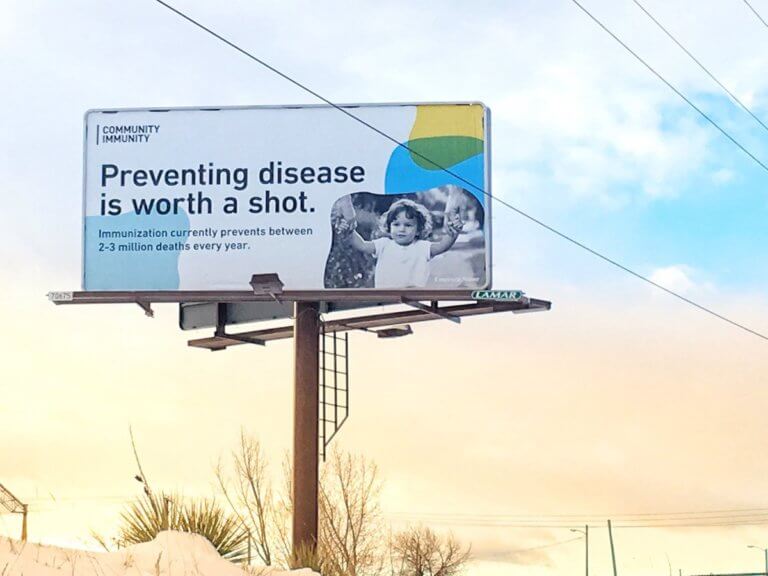
As we gladly say goodbye to this peculiar year that’s left us feeling exasperated for what feels like a decade, hope is slowly seeping through the creeks in the form of a vaccine that may revivify our world. The COVID-19 virus has affected every aspect of our lives today. Industries are constantly trying to cope with the necessary changes in order to survive in a sinking economy. However, a vaccine can mean a step closer to restoring the economy and reverting back to life as we knew it – pre-pandemic. For companies in the marketing industry, a vaccine could determine what marketing strategies will be used and how they will be implemented to target consumers who have been in lockdown for the majority of the year. Out-of-home (OOH) advertisements will surely be the star of the show as advertisers and companies will want to make their comeback on a well-lit and larger than life medium that has the power to avert bypassers’ attention off of their mobile screens. OOH can also act as a trusted source for health officials to advertise the vaccine and influence the public’s decision-making.
OOH During the Pandemic
Though the pandemic has given people a thirst for the outdoors, the OOH industry is still facing some challenges to meet consumers in places that were once crowded, like shopping centers and public transit, which are now almost all vacant. Additionally, companies have cut back on marketing expenses like ad spaces on travel routes that don’t have a high traffic rate. Billboard companies such as Outfront Media, a company that sells OOH ad space, claims to have a 50% decline from the previous year in an earnings report of the overall revenue for the second quarter of 2020, as a result of the lockdowns in the United States. Similarly, Clear Channel Outdoor and JCDecaux made comparable claims of decreasing revenue during the same period. However some brands and organizations managed to seize this opportunity to stand out from their competition and turn an unfortunate situation into a positive one by using OOH ads to deliver positive, creative, informative and even humorous ads during the lockdown.
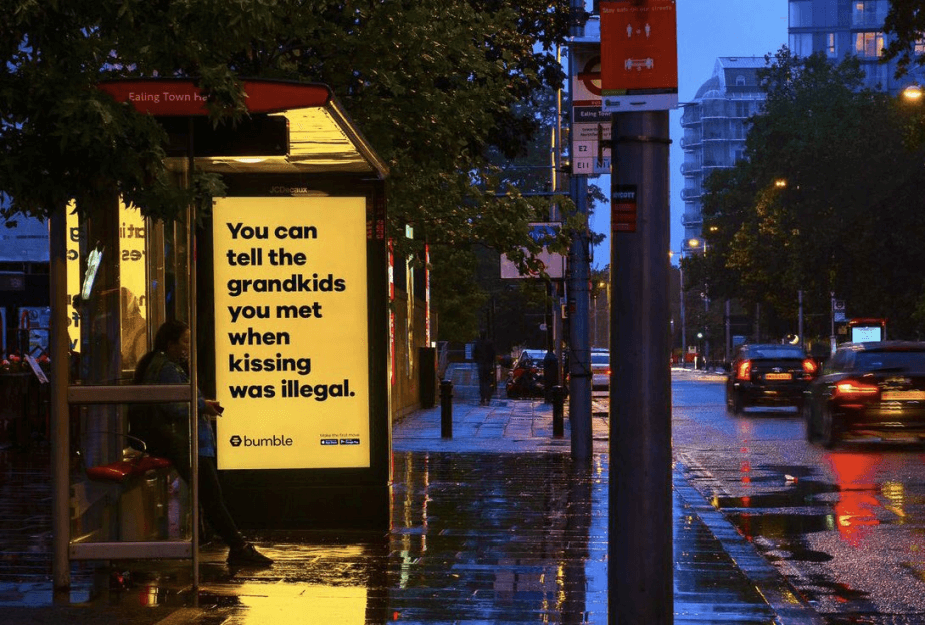
An example of a company that used OOH advertisements in the midst of the pandemic is Bumble. Bumble is a location-based social app that facilitates communication between users. At a time when communication is far from the norm, Bumble decided to approach the matter with some humor and positivity.
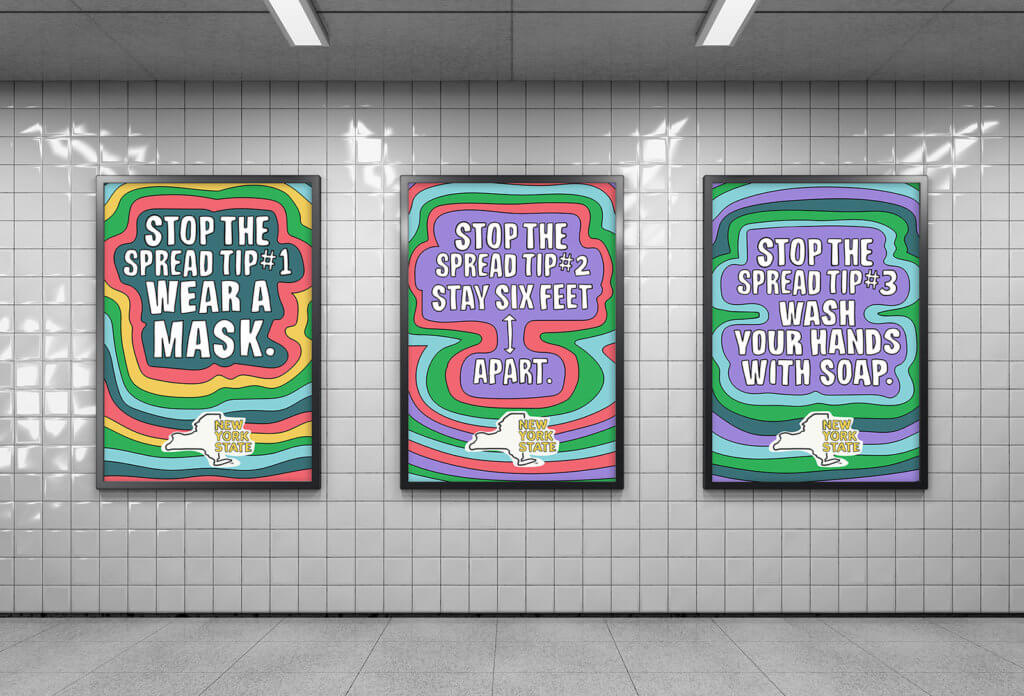
During the months where cases seemed to simmer down in New York City and people began roaming the streets and taking the subway again, The New York State officials created a colorful OOH advertisement to remind people of the necessary steps needed to proceed with caution when they’re in crowded places.
These examples demonstrate how OOH can be utilized to reach a large population whether that be for instructive purposes or for moral support because such ads can make a difference during difficult times. Moreover, these ads also help OOH advertising companies stay afloat and resilient during tough times.
OOH Will Prevail Post-Vaccine
Before the pandemic hit and lockdowns were initiated, OOH advertising was incorporating more digital advancements that were accelerating their growth rates faster than most other advertising mediums. If the vaccine proves to be effective and is widely distributed, we can predict that OOH advertising can resume previous efforts and grow exponentially. Advertisers are confident that the worst possible scenario has passed and people may soon be able to go back to their normal routines, pre-pandemic. This analysis is based on the brief time between the first and second wave of Covid-19 cases, when people began to feel like the virus had died down. Mr. Male of Outfront Media said that, “the return of OOH ads in New York suggested that cities are going to be hugely relevant even after the Pandemic, as young people are a prime target for advertisers and would continue to flock to urban areas”. This observation can be applied and amplified to what the market might look like after the vaccine is made available.
The pandemic has created many unknown variables and the economical situation is surely one of them. In such circumstances, consumers feel they must think twice before indulging in non-essential acts and opt for the safe route instead. However, as the Covid-19 vaccine gets closer to becoming a reality, consumers are more inclined to splurge when they feel their normal life is almost within reach. As consumers and businesses begin to feel a sense of security again, their confidence in investing in the future will also follow. Jack Kleinhenz, chief economist of the National Retail Federation, said it best when he stated that, “The psychology of the consumer isn’t just what he has in his pocket but what that will look like in the future”. Businesses look further into the future when they invest and hire, and with that in mind, some businesses are starting to spend more with faith in a newly improved year. This can have a domino effect on the cycle of consumers spending behaviors and the significance of advertising it presents. Businesses can provide consumers the reassurance and encouragement to lessen their financial constraints and revert back to their previous purchasing habits. As consumers once again begin to shop for more than their essential needs, the demand for marketers and advertisers will be highly prioritized as well.
As brands will need to redirect their efforts to advertising once again, the medium they choose to redeem themselves will have to meet high expectations. Some of the fundamental factors advertisements must possess are messages that give confidence to consumers to encourage purchasing behavior, creativity to stand out from the competition, a high level of engagement such as an experience consumers have missed during the pandemic, and a well-priced medium to accommodate budget spending. OOH fits the criteria needed, therefore we can predict that OOH will be in high demand post-vaccine. Advertisers and brands can use the fact that the pandemic is coming to an end for creative execution and messaging, just as they did during the pandemic, only this time it will be a call for celebration. If the vaccine is successfully implemented and lockdowns are lifted, we can only imagine the level of excitement consumers will experience as they revel in the joy of being out and about again. OOH ads will surely bring the streets to life once again, and be able to meet people where they are – as they visit all the places they have missed during the pandemic. We can anticipate a bombardment of OOH ads of brands that have been struggling during the crisis as well as experiential OOH that involves social interaction – something consumers have not experienced for a long period of time, which will ultimately result in a high demand for OOH advertising companies.
How Will the Vaccine be Advertised?
During the first wave of Covid-19 cases, there were numerous OOH ads that addressed the public by urging them to stay home and stay safe. Although it may be contradicting to use an OOH ad to tell people to stay at home, the choice of medium remains relevant due to the high impact OOH ads have on the masses. It has the ability to send a straightforward message directly from health officials, giving the ad more credibility. This advantage can be used to send encouraging messages while providing public awareness about the vaccine. This is especially true since the amount of misinformation about the vaccine on the internet is reaching critical levels, which consequently is reinforcing vaccine hesitation. Vaccine hesitancy can be traced back to 1796 when vaccinations were administered for the first time. Many people already have negative views about vaccines in general, especially the Covid-19 vaccine that was created in a relatively short period of time. OOH can be used to impact the public on important yet controversial subjects. There have been many anti-vaccine awareness campaigns in the past that have used OOH to voice their opinions. However, these campaigns almost always receive complaints for being misleading and end up being changed or removed.
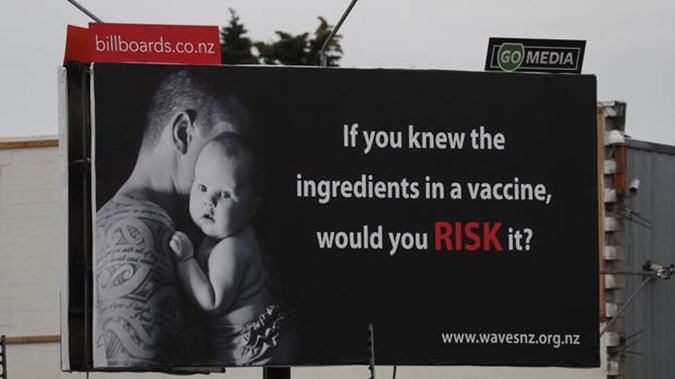
An ad for an anti-vaccination group named Waves NZ, displayed a man holding a baby with the words, “If you knew the ingredients in a vaccine, would you RISK it?” The ad received complaints about it implying that vaccines are not safe. The ad was promoting and encouraging consumers to research the ingredients of a vaccine before taking it. The Appeal Board agreed that consumers have the right to know, but the advertisement was removed for provoking fear through the text and imagery.
In the case of Covid-19, a pro- and anti- vaccine war has been taking place on social media for quite some time now. We can predict that this battle will begin making appearances on a larger scale through OOH ads.
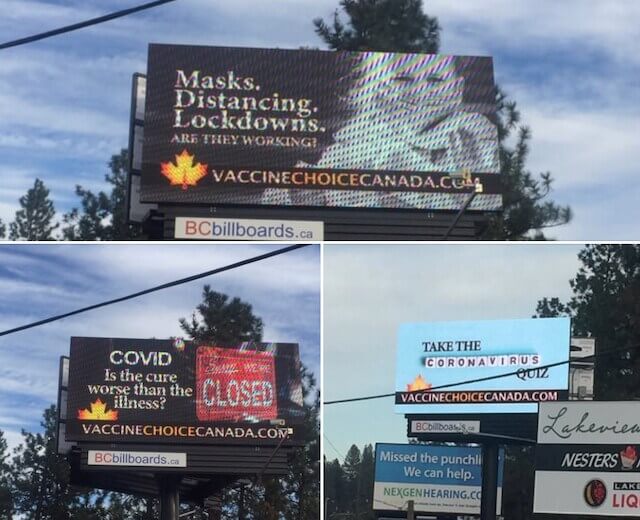
A series of ads were displayed in B.C. in November by Vaccine Choice Canada to spike skepticism towards the Covid-19 vaccine, with messages like, “COVID. Is the cure worse than the illness?” and, “Masks. Distancing. Lockdowns. Are they working?”. However, the ads don’t make any statements against the vaccine but are rather questioning it and the measurements being taken to prevent the spread of the virus. The purpose of the ad was more of a fight against the possibility of a mandatory vaccine. This ad may be the start of many, as Health officials will surely advertise the vaccine when it becomes available to the public.
Health officials will need to gain the trust of the public especially since pharmaceutical companies have always struggled with their reputation. According to a Gallup poll, 42% of Americans say they would not agree to get an FDA-approved Covid-19 vaccine. 37% of Americans say they would not get vaccinated because they don’t trust the rushed timeline of the vaccine development. 26% of Americans want to wait and see how others will respond to the first doses. 12% generally do not trust vaccines and will not take them. In order to market the vaccine efficiently, health organizations will need to draw attention towards the probability of getting infected, the risks the virus presents, and the value of prevention.
OOH Vaccine Ads
Governments and organizations are usually the ones behind these types of campaigns and their messages are often shared through a mixture of radio, television news and commercials, billboards, and social media. With social media becoming a beacon for misinformation and trust being the key player in persuading the population to take the vaccine, social media would not be the ideal medium in this situation. OOH might be the more convenient choice when considering public awareness and reaching the anti-vaccine population that are not interested in engagement on the subject. To get an idea of how marketers might advertise the vaccine, previous ad campaigns for flu shots might give us an idea of what to expect. The campaign called ‘Just the Flu’ by M&C Saatchi produced for the NHS and Public Health England, advertised the emphasis on the dangers the flu has on the community while showcasing a trusted figure of an NHS nurse. The COVID vaccine ads can use the same persuasive messaging to promote population wellness as opposed to personal health.
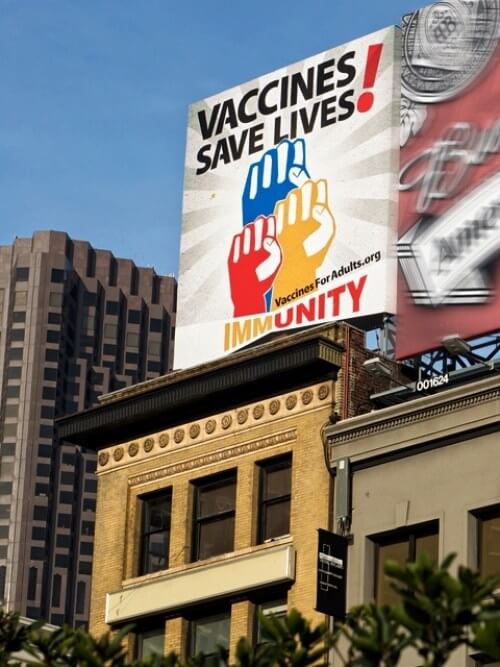
Additionally, applying a modern approach by endorsing a respected influencer that the public trusts and that resonates with millennials, such as actors, athletes, politicians, and religious leaders to promote the vaccine, can have an enormous impact on relieving some skepticism and fear.
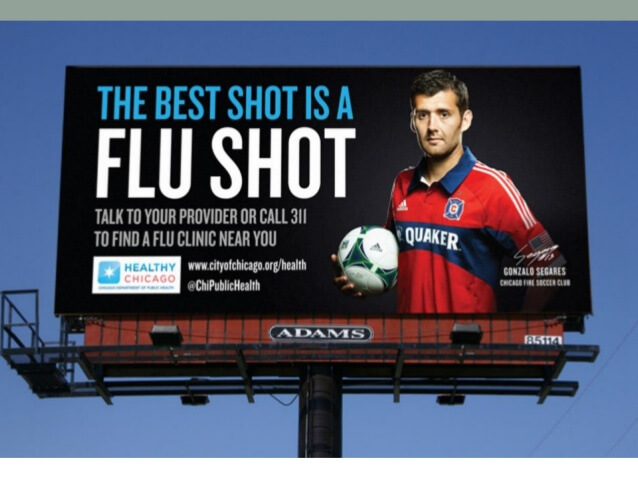
Another persuasive factor is reverting to the past as a reliable source, reminding people of past viruses that are no longer a threat to society because of the availability of a vaccine that was made possible by the same industries that are asking for the consumer’s trust today.
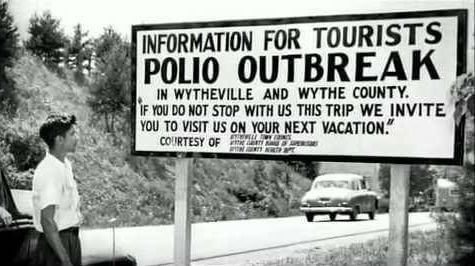
The Bottom Line
The recent progress towards the development of an awaited Covid-19 vaccine is causing a momentous amount of opposing opinions on the acceptance of the vaccine. Health officials and anti-vaccine organizations will both want to convince the public to side with their beliefs and the only way to do so is through marketing and advertising. By the research presented in this article, we can conclude that OOH ads will be used to influence the public to take the vaccine; inevitably counter ads will respond with messages warning the public not to participate. For these reasons, advertisers need to focus on acquiring the trust of consumers to achieve their goal. If the Covid-19 vaccine is successful in convincing a high percentage of people who are reluctant to take the vaccine, the world may begin to recover from the various constraints the virus has presented. Slowly but surely, businesses will prosper again which in effect will lift the economy back on its feet. As consumers will be able to enjoy the finer things in life once again, their purchasing behaviors will resemble that of the past. Additionally, the lockdown has left people with a newfound appreciation for the outdoors, giving OOH advertisements a unique advantage. The OOH advertising industry will act as the breath of fresh air consumers are seeking, as they look forward to experiences outside of their digital devices.


